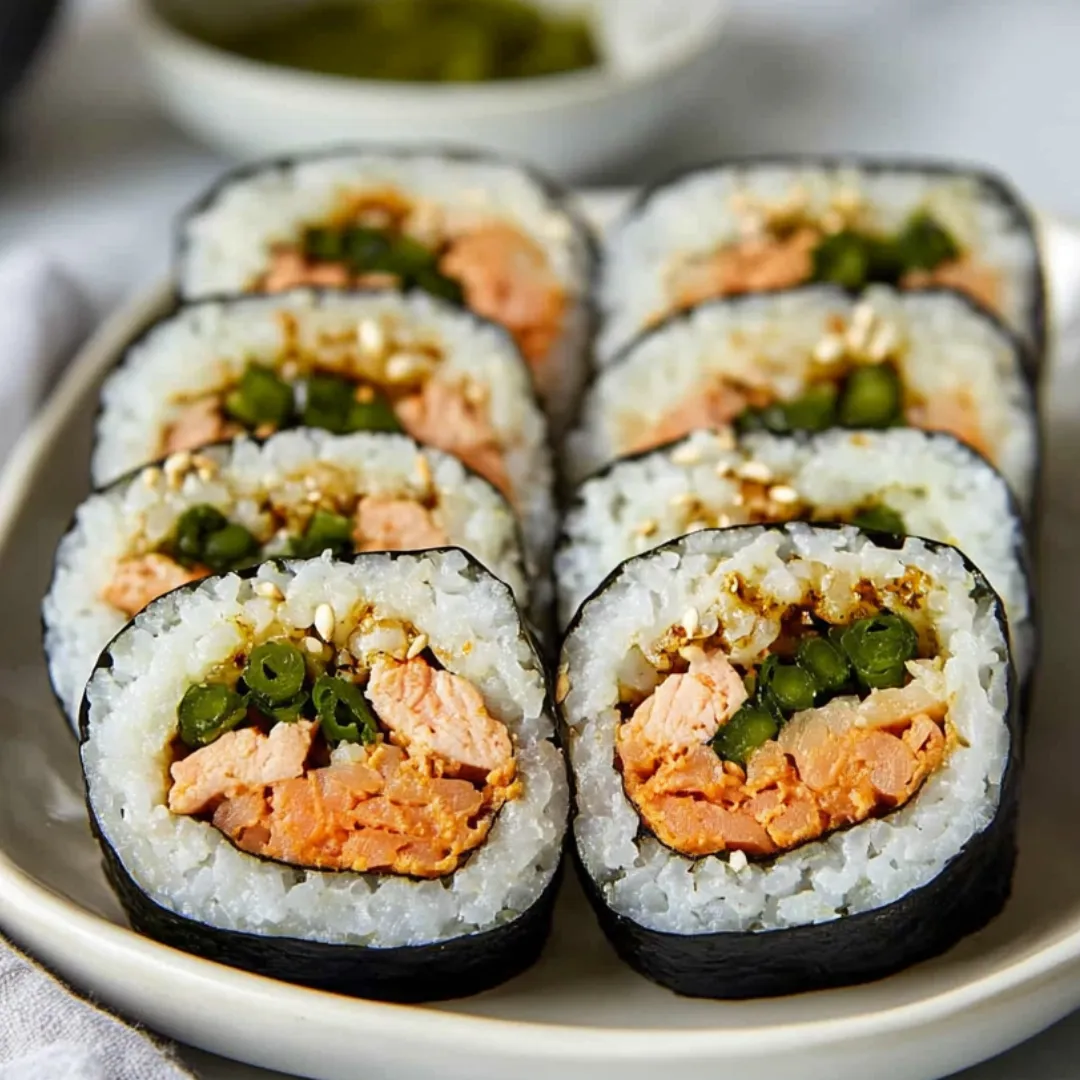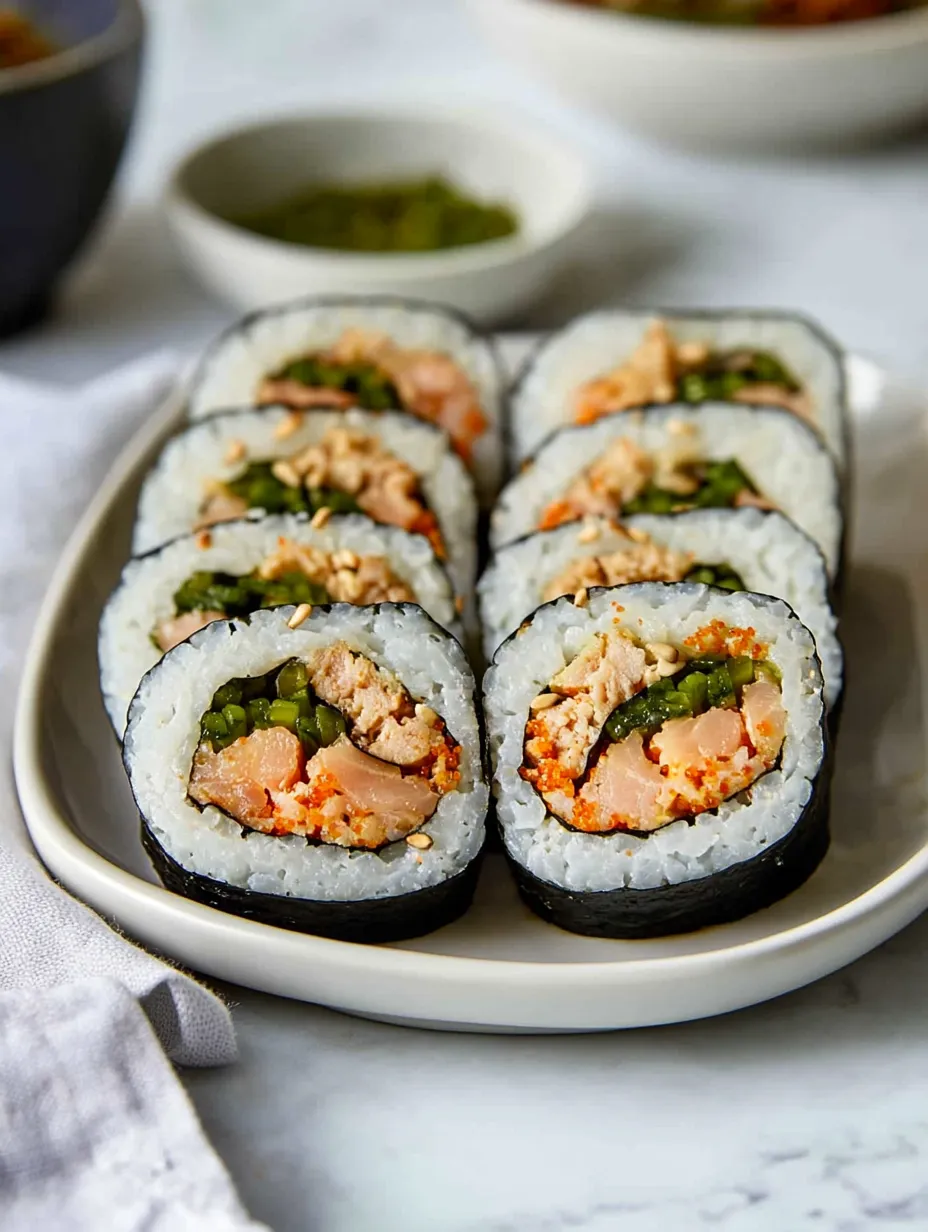 Pin
Pin
This filling spicy tuna kimbap has become my favorite quick fix that still packs tons of flavor. When you mix the flavored rice with savory tuna and fragrant perilla leaves, you get this amazing blend of textures and tastes that hits the spot every time.
I came up with this during one super busy week when I needed something fast but tasty. Nobody in my family thought homemade kimbap was a good idea at first, but now we can't go on road trips or picnics without it.
Ingredients
- Nori sheets: newer packs give you better wrap quality and taste
- Perilla leaves: they add this amazing mint-like flavor, but you can use lettuce if you're in a pinch
- Short grain rice: you need this specific type for that sticky feel that keeps everything in place
- Canned tuna: oil-packed brings more taste but water-packed works for a lighter option
- Japanese mayo: grab Kewpie if you can since normal mayo just doesn't have that same rich taste
- Sriracha sauce: lets you control the heat while adding some garlicky notes
- Sesame oil: get the toasted kind for that nutty smell that makes Korean food so good
- Sesame seeds: they give a nice little crunch and make your rolls look better
Step-by-Step Instructions
- Prepare the tuna filling:
- Drain your canned tuna completely using a small strainer and push with a fork to get rid of all extra liquid. This keeps your kimbap from getting mushy. Mix with chopped green onions, Japanese mayo, and sriracha in a bowl until everything's combined but still has some chunk to it. You want it to stick together but not turn into paste.
- Season the rice:
- Always use hot rice that's just been cooked. The heat helps mix in the sesame oil, seeds, and salt throughout every grain. Put a wet towel over it after mixing so it stays moist and sticky, which you'll need for good rolling.
- Set up your rolling station:
- Put your nori sheet with the rough side facing up on a clean board or bamboo mat if you've got one. The roughness helps rice stick better when rolling. Keep your hands slightly wet so rice doesn't stick to them when spreading.
- Spread the rice layer:
- Drop a cup of seasoned rice in the middle of the nori and push it outward with gentle pressure, but leave an inch empty at the top. Make sure your rice layer is even without pressing too hard, or your kimbap will end up too dense.
- Layer the fillings:
- Put perilla leaves overlapping down the middle of the rice to create a barrier for the spicy tuna mix. Form the tuna into a one-inch thick line centered on the leaves. Don't try to spread it too thin or it'll squish out when you roll.
- Execute the rolling technique:
- Start rolling from the bottom edge nearest you, keeping steady pressure the whole time. Use your fingertips to tuck filling in as you go, making sure it stays in a tight tube shape. Let the roll sit briefly on the final edge so the warm rice naturally seals it.
- Finish with seasoning:
- Brush some sesame oil lightly on your finished roll for extra flavor and a nice shine. This also stops the nori from getting too chewy and helps sesame seeds stick when you sprinkle them on top.
- Slice with precision:
- Put a little oil on your knife before cutting to stop sticking. Hold the roll firmly but gently and use a back-and-forth motion to make clean one-inch slices. Wipe and oil your knife between cuts for the neatest look.
 Pin
Pin
Those perilla leaves really make this dish special. I found out how important they are during a trip to South Korea when an elderly local woman told me they're absolutely necessary for real kimbap. They taste like a mix of mint and basil with a hint of licorice that goes perfectly with spicy tuna.
Storage Guidelines
Nothing beats freshly made kimbap when the seaweed is still nice and crisp. But if you need to make it ahead, wrap each roll tightly in plastic. This keeps moisture out that would make the seaweed soft. Try to eat refrigerated kimbap within a day and let it warm up to room temperature before eating so it tastes and feels right.
Clever Substitutions
You can tweak this recipe based on what's in your kitchen. Can't find perilla leaves? Try baby spinach or butter lettuce for that protective layer. Don't want tuna? Canned salmon or leftover shredded chicken with the same sauce works great. Going vegetarian? Swap the tuna for diced tofu or tempeh soaked in some soy sauce, sesame oil, and sriracha. No Japanese mayo around? Mix regular mayo with a splash of rice vinegar and a pinch of sugar for a good stand-in.
 Pin
Pin
Serving Suggestions
Kimbap usually comes with kimchi for a tangy crunch on the side, but there are lots of other good pairings. A small cup of miso soup turns it into a complete light meal. For a fancy starter, put slices on a pretty plate with some wasabi-spiked soy sauce for dipping. When you're taking it on picnics or trips, wrap each piece in parchment or plastic for easy eating. For family meals, make several kinds with different fillings and put them all on a big platter so everyone can try each type.
Cultural Context
Kimbap holds a unique spot in Korean food traditions as both daily fare and celebration food. Unlike Japanese sushi that often has raw fish, Korean kimbap usually contains cooked or preserved fillings, making it safer for lunch boxes and outdoor eating. It really took off in the 1950s as a handy portable meal for workers and students. The name blends "kim" for seaweed and "bap" for rice, showing its main ingredients. Many Korean families make kimbap together, with each person handling part of the process, creating both tasty food and family memories.
FAQs About the Recipe
- → What kind of tuna works best?
Any canned tuna works fine, whether packed in oil or water. Just make sure you drain it well first.
- → What can I use instead of perilla leaves?
Don't have perilla leaves? Regular green lettuce or even spinach leaves will do the trick.
- → How do I make it more or less spicy?
Just add more sriracha if you like heat or use less if you don't. You can also try gochujang for a different Korean kick.
- → Why do my rolls fall apart sometimes?
Make sure you spread everything evenly and roll them tight but don't squeeze so hard that the filling comes out.
- → How can I cut the rolls neatly?
Get a really sharp knife and wipe it with sesame oil between cuts so it won't stick to the rice.
